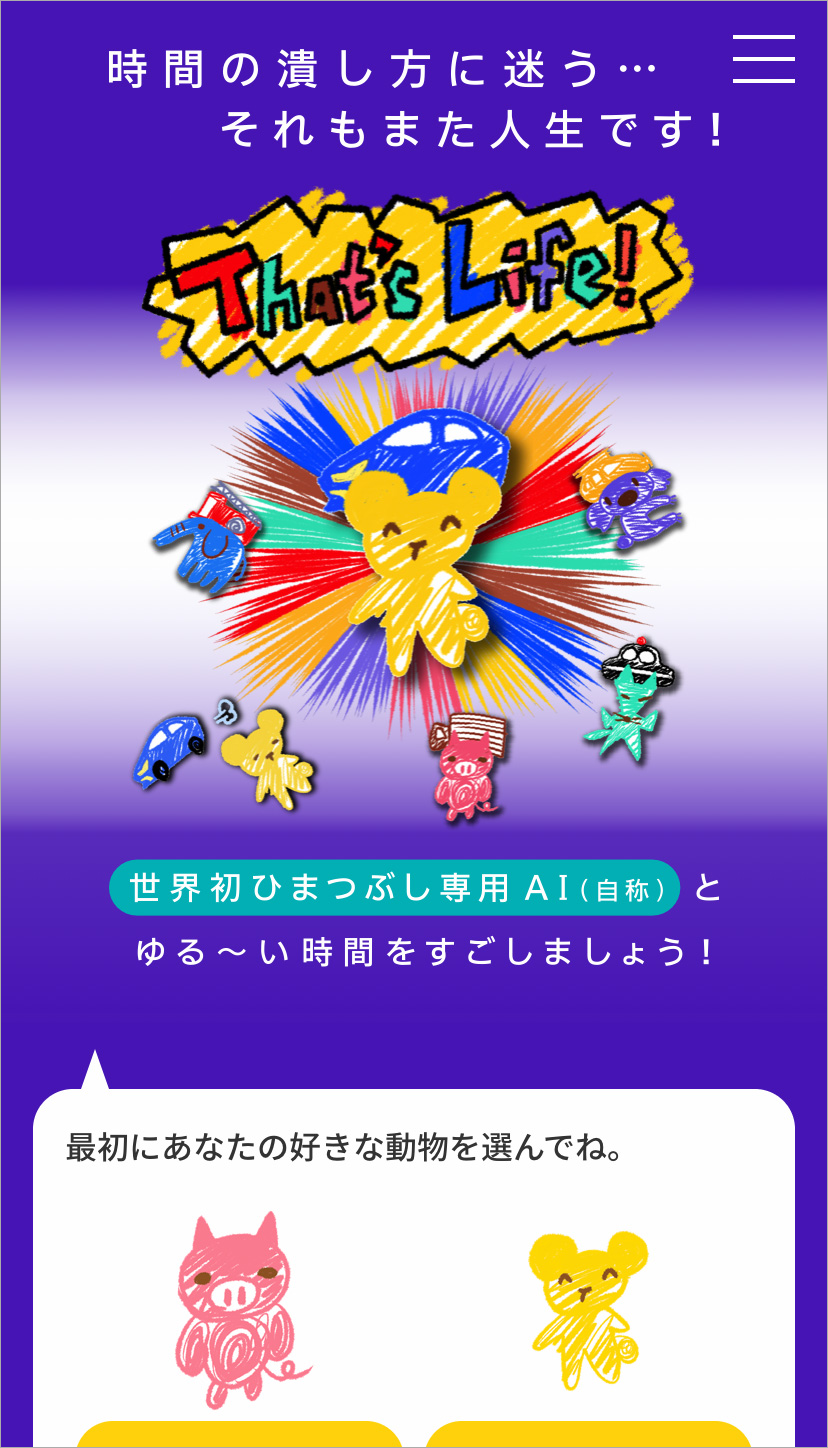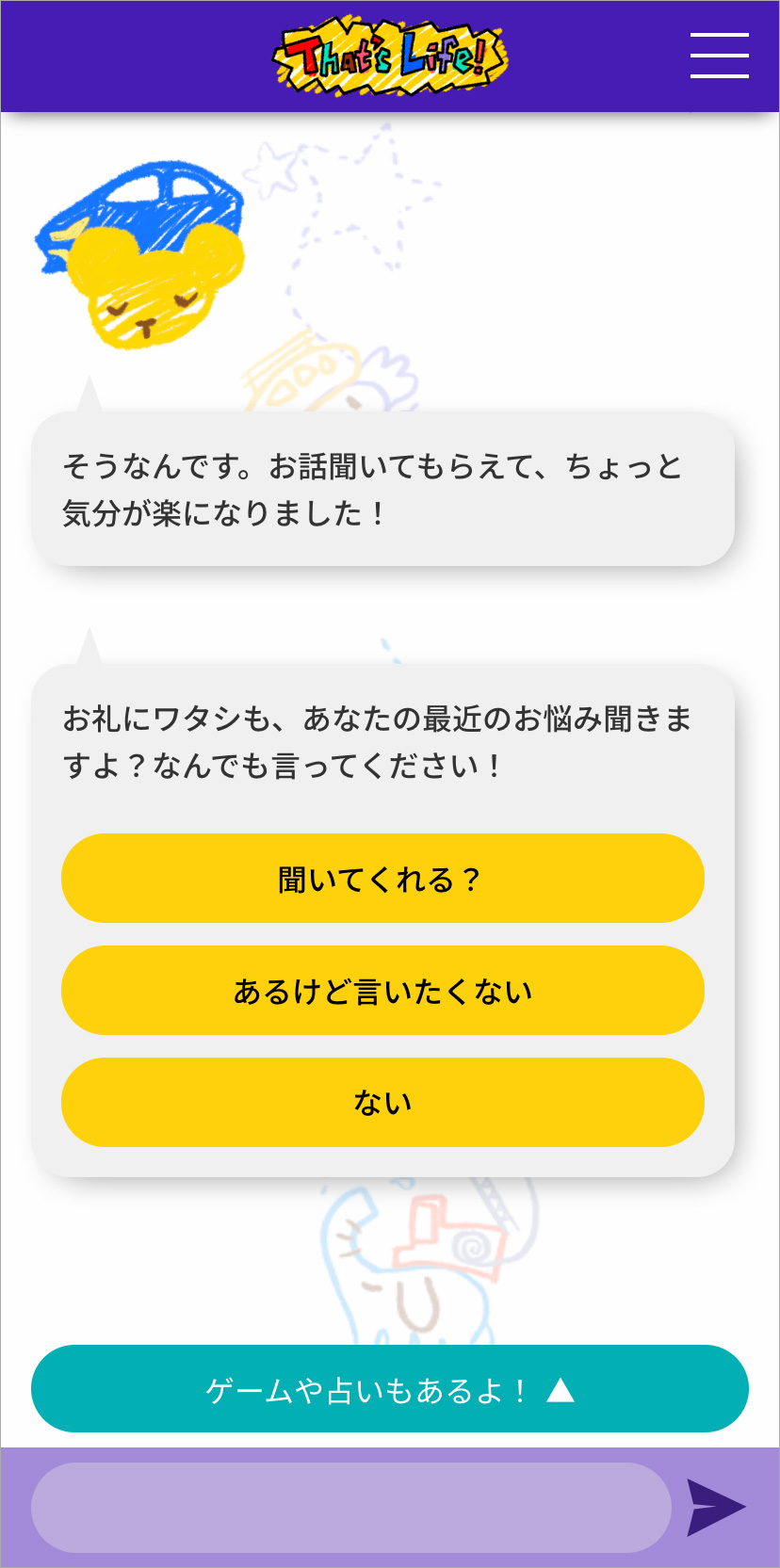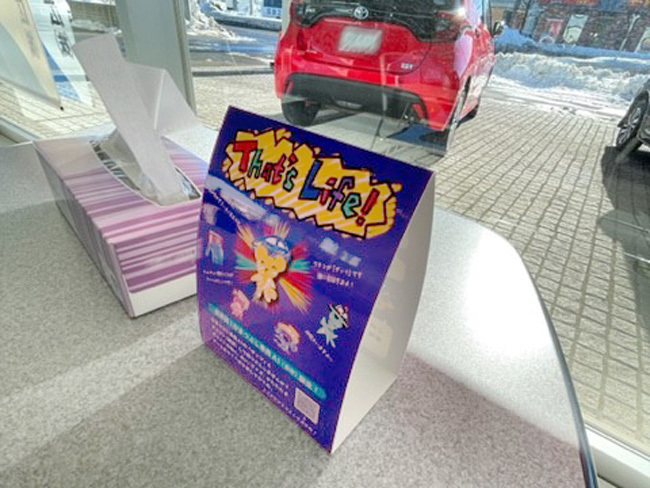Note: This website was automatically translated, so some terms or nuances may not be completely accurate.
A chatbot designed purely for killing time tried connecting users and companies through casual conversation.
Many people may still think of AI chatbots as "tools for automating FAQs and improving corporate efficiency."
However, the role of AI chatbots is now expanding.
This article focuses on the 'small talk capability' of AI, identified through Dentsu Inc.'s accumulated expertise from operating AI chatbots. Together with Rinna, the well-known small talk AI chatbot, we explored the potential for communication with consumers.
Based on our hypothesis and the results of our proof-of-concept experiments, Takashi Hotta from Dentsu Inc. Business Co-creation Division Technology Development Department will present our findings.
What kind of AI chatbot would make you want to talk about yourself?
In this series, we've introduced several examples of AI chatbots developed by Dentsu Inc.
Past articles on AI chatbot cases can be found here:
・How We Created "Shibuya Mirai," the Elementary School AI Living in Shibuya Ward.
・Teaching an AI Chatbot the Work of a Car Dealership.
Through these initiatives, we've learned that "users tend to be more willing to talk about themselves with chatbots that have distinct personalities."
For example, when a character-driven AI chatbot asks a question, some users respond more thoroughly than they would with a non-character-driven AI chatbot.
Furthermore, among the responses from users who continued the conversation,
- - Sharing their day's events as if you were their drinking buddy
- or confiding their feelings during times of anxiety, like after an earthquake
These patterns revealed deeper insights into users' lives through conversation.
Based on the accumulation of such case studies and know-how, we hypothesized that using character chatbots could help us learn more about the users who engage with them.
Based on this hypothesis, we conducted a proof-of-concept experiment with the title mentioned above:
"Chatbot for Killing Time"
in collaboration with Toyota Motor Corporation and "rinna," famous for its former AI high school girl "Rinna" (who graduated high school in March 2019).
The Birth of "That's Life," the Time-Killing AI Chatbot
The impetus for developing this dedicated time-killing AI chatbot came from a research and development consultation with Toyota Motor Corporation. They expressed a desire to "help customers enjoy their waiting time at dealerships while learning more about them and strengthening engagement."
We then conceived a new solution combining two types of AI chatbots: one designed to "become friends with users" and another to "listen to users," enabling the bot to "gather information about the other person while chatting casually."
The former is Rinna, an AI chatbot skilled at casual conversation, while the latter is Dentsu Inc.'s Kiku-Hana, a chatbot specialized in understanding Japanese meaning.

By combining these two AI chatbots, we aimed to make customers' downtime enjoyable while subtly gathering information about them through conversation. The result was the "That's Life" AI chatbot, designed specifically for killing time.

"That's Life" is a chatbot featuring "That's," a doodle-style bear who is adorably imperfect yet loves to chat, engaging in casual conversation, fortune-telling, and games. The next section explains its specific design.

What Character Traits Matter for a "Small Talk AI Chatbot"
Developing an AI chatbot for "casual conversation" presented a significant challenge. The core issue was the inherent complexity of spoken Japanese.
English chatbots benefit from clear word spacing and structured grammar, enabling highly accurate conversations.
However, with Japanese, especially spoken language, subjects and predicates are often omitted, and communication frequently relies on understanding the full context. This makes it difficult for AI to handle all situations.
Furthermore, "That's Life" utilizes Rinna's unique feature—unlike other AIs—to communicate by "responding to any user's statement and turning it into a conversation."
By responding to every utterance, it aims to spark casual conversation with users and enhance customer relationships, making it an optimal solution for that purpose.
On the other hand, while well-matched responses can lead to interesting conversations, there's also the possibility of completely irrelevant answers.
The most crucial factor is whether the customer finds it enjoyable. If the customer doesn't enjoy it, the casual conversation won't work.
So, how can we address this issue? This is where "character" becomes crucial.
For example, when chatting with "That's Life," users might sometimes feel like "the conversation isn't connecting." In those moments,
the user might think, "Well, that's just how this character is,"
—the user's perception changes.
For enjoyable small talk, it's crucial that users first empathize with or find the character itself interesting before the conversation even begins.
"That's Life" prioritized "making customers enjoy themselves" while designing a character that users would find forgiving of Japanese language difficulties. This led to a character resembling a rough, scribbled doodle. Because it's a rough doodle, its topic shifts and speech patterns can be a bit "sloppy" at times, but it's designed to be somehow endearing.
Leveraging this "roughness," the character is designed so that even when conversations don't connect, a quick buffer like "Sorry for being a bit rough" can be inserted. This helps reduce the discomfort of "not getting through" to the other person.
We also designed the logic for drawing out customers' own stories to leverage this character trait.
For the customer-facing questions, we use Dentsu Inc.'s "Kiku-Hana" to logically structure inquiries and responses. However, it's obvious that if a user is suddenly asked mid-conversation, "By the way, what's been bothering you lately?", they're highly unlikely to answer.
Therefore, in the flow of conversation touching on the customer's own matters, we've incorporated moments where the chatbot initiates talking about "its own things" first, leveraging its "slightly rough around the edges" character.
Furthermore, by deliberately inserting sudden "casual topic shifts" (we call them "conversation shifts from completely unexpected angles") at times, we aim to create an atmosphere where users feel comfortable talking about themselves.
For example, as shown in the next screen, we start by sharing "That's" own concern with the user.

After that, "That's" expresses gratitude

and then asks about the user's own concerns.
Past cases show that inserting such opening lines effectively lowers the psychological barrier users feel when conversing with an AI chatbot.
Could this be the start of an AI chatbot "getting to know the user"?
The newly developed "That's Life" began a field trial at Net Toyota Obihiro and Net Toyota Toyama dealerships starting January 15th.


This pilot enables communication where the AI chatbot "learns about users and leverages that knowledge for their benefit."
While still in the middle of the trial, Mr. Takanobu Hirakoshi, the Toyota representative overseeing the project, shared his enthusiasm after seeing it in action: "We hope the synergy between dealership staff and the AI chatbot will deepen communication between staff and customers, leading to even more wonderful experiences and services for our customers."
AI chatbots cannot simultaneously convey information to large groups. However, they hold the potential to deeply understand the individual they are interacting with one-on-one and provide that person with the most suitable information and services.
For example, suppose a conversation reveals that a user often enjoys an evening drink at a certain time.
By digging deeper into this—asking "What snacks do you have?" "Do you drink alone or with others?" "What kind of drinks do you prefer?"—we can uncover their unique preferences. If, for instance, they say "I drink on Wednesdays after working out, so I like refreshing drinks," we can recommend the perfect beverage for that specific moment.
Moving forward, to increase the likelihood customers choose our services or products, we believe it's essential for companies to take proactive steps to understand customers better, moving beyond one-way communication. To truly connect with customers and foster a positive perception of our company, gaining deep insights into their preferences is a crucial factor.
In this context, if we can leverage AI chatbots as tools for "understanding users," I imagine it could lead to providing better services for each individual customer a company interacts with.
Was this article helpful?
Newsletter registration is here
We select and publish important news every day
For inquiries about this article
Back Numbers
Author

Takahiro Hotta
Dentsu Inc.
Business Co-creation Bureau, Technology Development Department
The Business Co-creation Division develops and supports services using AI chatbots, as well as develops and operates chatbots with distinct personalities. It also engages in marketing support utilizing dialogue data.




